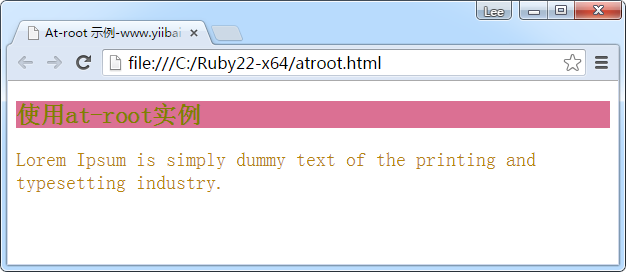Sass @at-root指令
@at-root指令是巢狀的規則的集合,它能夠使樣式塊在文件的根目錄。
@at-root (without: ...) 以及 @at-root (with: ...)
@at-root 選擇器預設不包括選擇器。通過使用@at-root我們可以將巢狀指令之外的樣式。例如,建立一個SASS檔案,用下面的程式碼:
@media print {
.style {
height: 8px;
@at-root (without: media) {
color: #808000;;
}
}
上面的程式碼將被編譯到CSS檔案,如下所示:
@media print {
.style {
height: 8px;
}
}
.style {
color: #808000;
}
範例
下面的例子演示了使用 @at-root 在SCSS檔案:
atroot.htmll
<!doctype html>
<head><meta charset="UTF-8"> <title>At-root 範例-www.tw511.com</title>
<link rel="stylesheet" href="atroot.css" type="text/css" />
</head>
<body class="container">
<h2>使用at-root範例</h2>
<p class="style">Lorem Ipsum is simply dummy text of the printing and typesetting industry.</p>
</body>
</html>
接下來,建立檔案 atroot.scss
atroot.scss
h2{
color: #808000;
background-color: #DB7093;
@at-root {
.style{
font-size: 20px;
font-style: bold;
color: #B8860B;
}
}
}
可以告訴SASS監視檔案,並隨時使用下面的命令更新 SASS 檔案來修改 CSS:
sass --watch C:\Ruby22-x64\atroot.scss:atroot.css
接著執行上面的命令,它會自動建立atroot.css檔案,下面的程式碼:
atroot.css
h2 {
color: #808000;
background-color: #DB7093;
}
.style {
font-size: 20px;
font-style: bold;
color: #B8860B;
}
執行輸出結果
讓我們來執行以下步驟,看看上面的程式碼工作:
儲存上面的html程式碼到atroot.htmll檔案。在瀏覽器中開啟該HTML檔案,得到輸出如下顯示
